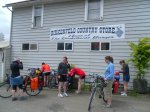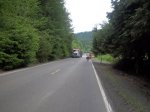So as most of you probably already know, I’m back in the US. I didn’t post any entries on this blog while actually in Europe, mainly because I didn’t want to spend a bunch of time on computers while I was there (sorry!). I did take notes though, so now I will do my best to recap my impressions of the various places I visited, starting with London. (You can pretend I’m still there, if you want 🙂
 I think I once heard someone say that cycling in London is suicide – or maybe that’s just a common sentiment for most big cities. I would disagree, and saw plenty of other people who weren’t deterred from riding bikes here. I will agree, it probably isn’t for the faint of heart – motor traffic in London is heavy, and those painted lines on the streets seem to be mere suggestions – cars, trucks and those staggering double-decker buses weave in and out of lanes when they encounter stopped taxis or buses or delivery trucks in their way. I saw few bike markings on streets, and often bike paths would be marked for only a few meters on the street (such as the bike lane that ends mid-bridge in the photo at left). I also saw few separated bike paths. (They do apparently exist – for example, Transport for London has several “bicycle superhighways” planned to get traffic from outer London to the center of town; I was mostly biking around the center of town already, though.)
I think I once heard someone say that cycling in London is suicide – or maybe that’s just a common sentiment for most big cities. I would disagree, and saw plenty of other people who weren’t deterred from riding bikes here. I will agree, it probably isn’t for the faint of heart – motor traffic in London is heavy, and those painted lines on the streets seem to be mere suggestions – cars, trucks and those staggering double-decker buses weave in and out of lanes when they encounter stopped taxis or buses or delivery trucks in their way. I saw few bike markings on streets, and often bike paths would be marked for only a few meters on the street (such as the bike lane that ends mid-bridge in the photo at left). I also saw few separated bike paths. (They do apparently exist – for example, Transport for London has several “bicycle superhighways” planned to get traffic from outer London to the center of town; I was mostly biking around the center of town already, though.)
Also, biking around London smells like it could cause a slow death by asphyxiation – vehicle emissions were particularly noticeable on the busy roads. I saw a number of people wearing masks while riding – looking a bit silly but probably breathing easier than the rest of us. (Sadly I didn’t get a picture, but here’s someone’s post that summarizes one person’s experience with different kinds of masks.)
Despite all this, I really enjoyed riding around central London. I’m not generally a brave or “assertive” rider, I am more comfortable with plenty of space around me. But I found that taking the lane in heavy traffic got me nowhere, and had me breathing more smog. So I decided to copy the other bike riders I saw and squeeze between cars and buses. Much more efficient at getting places, and kind of thrilling, in the sense that you might have one of those red double-decker buses six inches to your left and cars a foot to your right. But no one could really go fast on these streets, so it didn’t really feel unsafe. It just required good balance and constant attention.
 Here’s one thing I really liked: the rental bikes were really easy, and really cheap, to check out. No membership is required (though you could have one if you lived there); it costs one pound to get access for 24 hours, and then you can check bikes out 30-minute increments at no extra cost all day long. Als0, they were everywhere throughout central London. People fondly refer to them as “Boris’s bikes”, after the mayor. (According to a couple of Londoners I talked to on the train, it’s one of the few initiatives of his that have been popular.) I’ve wondered whether bike-sharing systems like this can really be effective, because wouldn’t people rather just own their own bike? But I could easily picture this as an extension of the extensive public transit network.
Here’s one thing I really liked: the rental bikes were really easy, and really cheap, to check out. No membership is required (though you could have one if you lived there); it costs one pound to get access for 24 hours, and then you can check bikes out 30-minute increments at no extra cost all day long. Als0, they were everywhere throughout central London. People fondly refer to them as “Boris’s bikes”, after the mayor. (According to a couple of Londoners I talked to on the train, it’s one of the few initiatives of his that have been popular.) I’ve wondered whether bike-sharing systems like this can really be effective, because wouldn’t people rather just own their own bike? But I could easily picture this as an extension of the extensive public transit network.
London seems to be on a good track towards making cycling nicer – political support with plans for more bike paths, and a willingness to make driving less attractive, for example with the congestion charge. (Though that may have been simply necessary – as congested as the roads already are, I can’t imagine how bad traffic would be in central London without that charge.) Granted, I didn’t get much of a sense of how the outlying neighborhoods were for cycling. But it seems like there’s a ways to go before more than 2% of the population is ready to hop on a bike.






